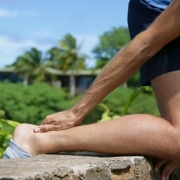STUDY FINDS GRADUAL GRADE CHANGE REDUCES RISK OF ACHILLES INJURY
Like many runners, former BYU track star Katy Andrews Neves has had her share of injuries. But unlike most runners, one of those injuries has been witnessed by millions of people around the world.
In what is now one of the top sports bloopers of all time, Neves was caught on camera in 2012 crashing over the water barrier in a steeplechase race at BYU. She hit her head and got several other bruises, but was luckily spared any serious injuries.
As a graduate student, Neves started researching running injuries focusing on the Achilles tendon. It is estimated that 52 percent of distance runners injure their Achilles at some point.
Now a new study authored by Neves and three BYU exercise science professors reveals potentially positive news about the Achilles—that the tendon is capable of adapting to uphill and downhill running better than previously believed.
"Runners can know it is safe to transition to downhill running and include it in normal training and racing," said Neves, who was an All-Conference performer in both the 5000m and steeplechase at BYU. "Though there are greater forces placed on your body during downhill running, the benefits can outweigh the risks."
Researchers asked 20 female runners to run three different times on an instrumented treadmill in BYU's Human Performance Research Center Biomechanics Lab. Each runner had to be able to run a 5K (5000 meters) in under 24 minutes.
The women ran at three different grades (-6 percent, 0 percent, +6 percent) on three separate days, with at least 48 hours between each round. Knowing that the Achilles becomes more pliant and thinner from exercise, researchers used Doppler ultrasound imaging to examine the thickness and stretch on Achilles tendons before and after each trial. Ten high-speed cameras recorded the motion of the runners, collecting data from 16 reflective markers placed on the runners' lower extremities.
While the downhill running resulted in the largest peak force on the runners, Neves and fellow researchers Bill Myrer, Wayne Johnson, and Iain Hunter, were surprised to find no significant differences in Achilles tendon thickness changes between running grades. The finding means there is no increased risk for Achilles injury when running at different grades.
"Over time, runners adapt to the forces placed on their body, so even when the forces are higher (running downhill), if the adaptation process is gradual, the injury risk drops," Neves said. "Our bodies are amazing and are very good at adapting to the conditions we put them in."
That being said, authors warn that runners should transition slowly to downhill running in order to adapt to the greater forces.
"The main cause of any running injury is a sudden change in training," said Hunter, BYU professor of exercise science. "It seems obvious to gradually change your regimen, but it is a hard principle to follow and practice. Injuries from abrupt training changes just kind of show up one day."
The study, published recently in the Journal of Sports Science and Medicine, should have particular interest for marathon runners. The Boston, Chicago, New York City and Los Angeles marathons all include hill grades ranging up to 6 percent.


